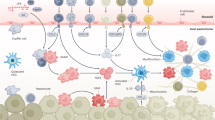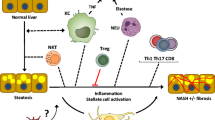Abstract
Nonalcoholic steatohepatitis (NASH) is a chronic inflammatory liver disease associated with insulin resistance and its metabolic consequences. Leukocyte mobilization, intrahepatic activation, and an exacerbated production of reactive oxygen species (ROS) and cytokines contribute to the development of NASH. Though alterations in peripheral blood (PB) T cell proportions and functionality remain unidentified, they might play a main role in NASH progression. We have compared the phenotype and Th1/Th2 commitment of peripheral immune cell reservoirs in adult patients and controls as well as the ability of neutrophils and monocytes to handle an ex vivo challenge. Also, we correlated those parameters with the main histological characteristics in NASH. Compared with controls, patients showed increased numbers of CD4+ cells and both CD4+ and CD8+ CD45RO subsets together with a higher frequency of IFN-γ-producing CD4+ and CD8+ T cells. We also found a decreased number of CD4+ and CD8+ CD45RA subsets. The distinctive production of IFN-γ highlights the significance of the observed skewed frequencies of PB T cells. Whereas ROS production by monocytes from NASH patients did not differ from controls, circulating neutrophils displayed a particularly higher phorbol myristate acetate-induced production of ROS. A negative correlation between oxidative burst and fibrosis grade was observed. This study reveals the presence of a characteristic profile of peripheral immune cells in NASH. We also discuss the probable influence of obesity on some of our present findings.





Similar content being viewed by others
References
Paschos P, Paletas K. Non alcoholic fatty liver disease and metabolic syndrome. Hippokratia. 2009;13:9–19.
Vuppalanchi R, Chalasani N. Non-alcoholic fatty liver disease and non-alcoholic steatohepatitis. Hepatology. 2009;49(1):306–17.
Zhan YT, An W. Role of liver innate immune cells in nonalcoholic fatty liver disease. World J Gastroenterol. 2010;16(37):4652–60.
Videla L. Oxidative stress signaling underlying liver disease and hepatoprotective mechanisms. World J Hepatol. 2009;1:72–8.
Pascale A, Pais R, Ratziu V. An overview of nonalcoholic steatohepatitis: past, present and future directions. J Gastrointestin Liver Dis. 2010;19(4):415–23.
Alberti GMM, Zimmet PM, Shaw J. Metabolic syndrome—a new world-wide definition. A consensus statement from the International Diabetes Federation. Diabet Med. 2006;23:469–80.
Brunt EM. Pathology of nonalcoholic steatohepatitis. Hepatol Res. 2005;33:68–71.
Brunt EM. Histopathology of non-alcoholic fatty liver disease. Clin Liver Dis. 2005;13(4):533–44.
Adams LA, Sanderson S, Lindor KD, Angulo P. The histological course of nonalcoholic fatty liver disease: a longitudinal study of 103 patients with sequential liver biopsies. J Hepatol. 2005;42:132–8.
Fassio E, Alvarez E, Dominguez N, Landeira G, Longo C. Natural history of nonalcoholic steatohepatitis: a longitudinal study of repeat liver biopsies. Hepatology. 2004;40:820–6.
Day C, James OFW. Steatohepatitis: a tale of two “hits”? Gastroenterology. 1998;114:842–5.
Basaranoglu M, Kayacetin S, Yilmaz N, Kayacetin E, Tarcin O, Sonsuz A. Understanding mechanisms of the pathogenesis of nonalcoholic fatty liver disease. World J Gastroenterol. 2010;16(18):2223–6.
Jasen PML. Nonalcoholic steatohepatitis. J Med. 2004;62:217–24.
Brunt EA, Kleiner DE, Wilson L, Unalp A, Behling CE, Lavine JE, et al. Portal chronic inflammation in nonalcoholic fatty liver disease. Hepatology. 2009;49(3):809–20.
Jaeschke H, Gores GJ, Cederbaum AI, Hinson JÁ, Pessayre D, Lemasters JJ. Mechanisms of hepatotoxicity. Toxicol Sci. 2002;65:166–76.
Seki S, Kitada T, Yamada T, Sakaguchi H, Nakatani K, Wakasa K. In situ detection of lipid peroxidation and oxidative DNA damage in non-alcoholic fatty liver diseases. J Hepatol. 2002;37:56–62.
Abdelmalek MF, Diehl AM. Mechanisms underlying nonalcoholic steatohepatitis. Drug Discov Today Dis Mech. 2006;3(4):479–88.
Vowells SJ, Sekhsaria S, Malech HL, Shalit M, Fleisher TA. Flow cytometric analysis of the granulocyte respiratory burst: a comparison study of fluorescent probes. J Immunol Methods. 1995;178:89–97.
Morel F, Doussiere JV, Vignais PV. The superoxide-generating oxidase of phagocytic cells. Physiological, molecular and pathological aspects. Eur J Biochem. 1995;201:523–46.
Kleiner DE, Brunt EM, Van Natta M, Behling C, Contos MJ, Cummings OW, et al. Design and validation of a histological scoring system for nonalcoholic fatty liver disease. Hepatology. 2005;41(6):1313–21.
Brunt EM, Janney CG, Di Bisceglie AM, Neuschwander-Tetri BA, Bacon BR. Nonalcoholic steatohepatitis: a proposal for grading and staging the histological lesions. Am J Gastroenterol. 1999;94:2467–74.
World Health Organization (WHO. Preventing and managing the global epidemic of obesity. Report of the World Health Organization Consultation of Obesity. World Health Organ Tech Rep Ser. 2000;894:i–xii. 1–253.
Berard M, Tough DF. Qualitative differences between naïve and memory T cells. Immunology. 2002;106:127–38.
Linton JP, Haynes L, Tsui L, Zhang X, Swain S. From naive to effector – alterations with aging. Immunol Rev. 1997;160:9–18.
Kimmig S, Przybylski GK, Schmidt CA, Laurisch K, Mowes B, Radbruch A, et al. Two subsets of naive T helper cells with distinct T cell receptor excision circle content in human adult peripheral blood. J Exp Med. 2002;195(6):789–94.
Richards SJ, Jones RA, Roberts BE, Patel D, Scott CS. Relationships between 2H4 (CD45RA) and UCHLl (CD45RO) expression by normal blood CD4+ CD8−, CD4− CD8+, CD4− CD8dim+, CD3+ CD4−CD8− and CD3− CD4−CD8− lymphocytes. Clin Exp Immunol. 1990;81:149–55.
Li QF, Li YP, Cheng PS. Peripheral T-lymphocyte subsets changes in patients with endocrine and metabolic diseases. Zhonghua Nei Ke Za Zhi. 1989;28(7):410–2.
Romo EM, Muñoz-Robles JA, Castillo-Rama M, Meneu JC, Moreno-Elola A, Perez-Saborido B, et al. Peripheral blood lymphocyte populations in end-stage liver diseases. J Clin Gastroenterol. 2007;41(7):713–21.
Arizcorreta A, Márquez M, Fernández-Gutiérrez C, Guzmán EP, Brun F, Rodríguez-Iglesias M, et al. T cell receptor excision circles (TRECs), CD4+, CD8+ and their CD45RO+ and CD45RA+ subpopulations in hepatitis C virus (HCV)-HIV-co-infected patients during treatment with interferon alpha plus ribavirin: analysis in a population on effective antiretroviral therapy. Clin Exp Immunol. 2006;146:270–7.
Leon MP, Spickett G, Jones DEJ, Bassendine MF. CD4+ T cell subsets defined by isoforms of CD45 in primary biliary cirrhosis. Clin Exp Immunol. 1995;99:233–9.
Tanigawa T, Iso H, Yamagishi K, Muraki I. Association of lymphocyte sub-populations with clustered features of metabolic syndrome in middle-aged Japanese men. Atherosclerosis. 2004;173:295–300.
Yatsuji S, Hashimoto E, Kaneda H, Taniai M, Tokushige K, Shiratori K. Diagnosing autoimmune hepatitis in nonalcoholic fatty liver disease: is the International Autoimmune Hepatitis Group scoring system useful? J Gastroenterol. 2005;40:1130–8.
Bertola A, Bonnafous S, Anty R, Patoraux S, Saint-Pauk MC, Iannelli A, et al. Hepatic expression patterns of inflammatory and immune response genes associated with obesity and NASH in morbidly obese patients. PLoS One. 2010;5(10):e13577.
Smith SR, Calzetta A, Bankowski J, Kenworthy-Bott L, Terminelli C. Lipopolysaccharide-induced cytokine production and mortality in mice treated with Corynebacterium parvum. J leukocyte Biology. 1993;54:23–9.
Maher J, Leon P, Ryan J. Beyond insulin resistance: Innate immunity in nonalcoholic steatohepatitis. Hepatology. 2008;48:670–8.
Guebre-Xabier M, Yang S, Lin HZ, Schwenk R, Krzych U, Diehl AM. Altered hepatic lymphocyte subpopulations in obesity-related murine fatty livers: potential mechanism for sensitization to liver damage. Hepatology. 2000;31:633–40.
Wu H, Ghosh S, Perrad XD, Feng L, Garcia GE, Perrad JL, et al. T-Cell accumulation and regulated on activation. normal T cell expressed and secreted upregulation in adipose tissue in obesity. Circulation. 2007;115:1029–38.
Kintscher U, Hartge M, Hess K, Foryst-Ludwig A, Clemenz M, Wabitsch M, et al. T-lymphocyte infiltration in visceral adipose tissue: a primary event in adipose tissue inflammation and the development of obesity-mediated insulin resistance. Arterioscler Thromb Vasc Biol. 2008;28:1304–10.
Mantovani A, Sozzani S, Locati M, Allavena P, Sica A. Macrophage polarization: tumor-associated macrophages as a paradigm for polarized M2 mononuclear phagocytes. Trends Immunol. 2002;23:549–55.
McGillicuddy FC, Chiquoine EH, Hinkle CC, Kim RJ, Shah R, Roche HM, et al. Interferon γ attenuates insulin signaling, lipid storage, and differentiation in human adipocytes via activation of the JAK/STAT pathway. J Biol Chem. 2009;284(46):31936–44.
Rensen SS, Slaats Y, Driessen A, Peutz-Kootstra CJ, Nijhuis J, Steffensen R, et al. Activation of the complement system in human nonalcoholic fatty liver disease. Hepatology. 2009;50(6):1809–17.
Leclerq LA. Antioxidant defence mechanisms: new players in the pathogenesis of non-alcoholic steatohepatitis? Clin Sci. 2004;106:235–7.
Lefkowitch JH, Haythe JH, Regent N. Kupffer cell aggregation and perivenular distribution in steatohepatitis. Mod Pathol. 2002;15:699–704.
Guo RF, Ward PA. Role of C5a in inflammatory responses. Annu Rev Immunol. 2005;23:821–52.
Mollnes TE, Brekke OL, Fung M, Fure H, Christiansen D, Bergseth G, et al. Essential role of the C5a receptor in E coli-induced oxidative burst and phagocytosis revealed by a novel lepirudin-based human whole blood model of inflammation. Blood. 2002;100:1869–77.
Jaeschke H, Smith CV, Clemens MG, Ganey PE, Roth RA. Mechanisms of inflammatory liver injury: adhesion molecules and cytotoxicity of neutrophils. Toxicol Appl Pharmacol. 1996;139:213–26.
Poniachik J, Csendes A, Díaz JC, Rojas J, Burdiles P, Maluenda F, et al. Increased production of IL-1alpha and TNF-alpha in lipopolysaccharide-stimulated blood from obese patients with non-alcoholic fatty liver disease. Cytokine. 2006;33(5):252–7.
Nieto N, Friedman SL, Cederbaum AI. Stimulation and proliferation of primary rat hepatic stellate cells by cytochrome P450 2E1-derived reactive oxygen species. Hepatology. 2002;35(1):62–73.
Panasiuk A, Wysocka J, Maciorkowska E, Panasiuk B, Prokopowicz D, Zak J, et al. Phagocytic and oxidative burst activity of neutrophils in the end stage of liver cirrhosis. World J Gastroenterol. 2005;11(48):7661–5.
Harte AL, da Silva NF, Creely SJ, McGee KC, Billyard T, Youssef-Elabd EM, et al. Elevated endotoxin levels in non-alcoholic fatty liver disease. J Inflamm. 2010;7(15):201.
Acknowledgments
We wish to thank the patients for their cooperation. We also thank Dr. A.E. Feldstein for proofreading our manuscript.
Source of Funding
This work was supported by the Buenos Aires University (UBACyT M010); CONICET (PIP 6104), and A.N.P.C.y T (06–257). The funding sources had no involvement in study design; in the collection, analysis, and interpretation of data; in the writing of the report; or in the decision to submit the paper for publication.
Author information
Authors and Affiliations
Corresponding author
Rights and permissions
About this article
Cite this article
Inzaugarat, M.E., Ferreyra Solari, N.E., Billordo, L.A. et al. Altered Phenotype and Functionality of Circulating Immune Cells Characterize Adult Patients with Nonalcoholic Steatohepatitis. J Clin Immunol 31, 1120–1130 (2011). https://doi.org/10.1007/s10875-011-9571-1
Received:
Accepted:
Published:
Issue Date:
DOI: https://doi.org/10.1007/s10875-011-9571-1




